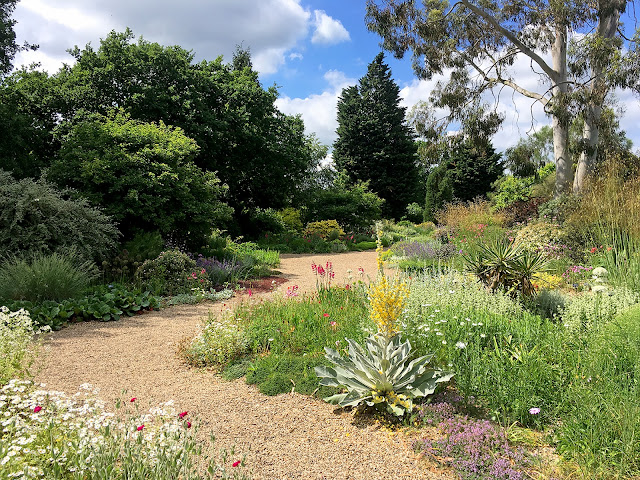Beth Chatto's Dry Garden
I think of England as a soggy place, but eastern England gets little rain. Weather coming from the Atlantic and across the island from the west has already unloaded its moisture before it gets to the eastern side. So their rain is scant and unpredictable.
Beth Chatto's garden is in Essex, on the east coast, and that's where she created her famous dry garden. It was an experiment begun in the 1960s and 70s to see what would grow in her dry, inhospitable part of England.
Her plant experiments were groundbreaking at the time and in 1991 she converted a former car park into a gravel garden that is still something to behold. Just look at the photo. Her gardens -- there are several in addition to the gravel garden -- are open to the public (she died in 2018) and some day I'd like to visit it.
When she began her experiments with natural plants suited to their environment and never watered, British horticulture dismissed it as "cultivated weeds", but her insistence on putting the right plants where they want to be and then not coddling them won over the critics.
Recently my Connecticut garden group read her 1978 book The Dry Garden and it was charming and informative in an old fashioned way. I had hoped her plant choices and design advice would help me in my own dry garden.
But here's the thing: her dry garden lives, unirrigated, on an average of 20 inches of rain a year. Double what we get in Santa Fe, and triple what we got last year, when 6 inches was our total for the year before winter set in.
Of course the 20 inches her Essex garden receives doesn't come at the right times and sometimes doesn't come at all for long periods, so her approach of not watering, ever, means she learned what would survive utter unpredictability and deep stress. And still look so beautiful. It's a testament to her genius that she could do this, and I can adapt her findings to my own conditions as long as I irrigate. There's a world of difference between 20 inches more or less and . . . . less.
Here's what the completely unirrigated patch of land next to our house looked like this past November, after a total of 6 inches of rain for the year:
That dry brown area next to our driveway has mostly grasses, a couple Russian sages, rabbitbrush, yellow flowered hairy goldenasters, and lots of wild sweet clover. Six inches of rainfall was not enough to keep any of it greened up for the season.
But in 2017 rainfall was about 14 inches for the year and this same open area looked like this in late fall:
Like Beth Chatto's gravel garden, the sandy area next to our driveway is never irrigated. All it needs is 14 inches of rainfall to look good.
Even better would be the 20 inches she receives, even if it falls erratically. With that amount of rainfall I know I could have something like her beautiful plantings next to our driveway.
Dream on.







Comments